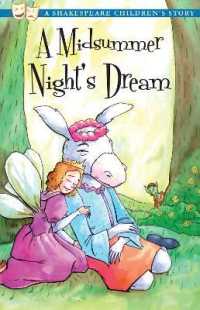- ホーム
- > 洋書
- > 英文書
- > History / World
Full Description
Examines the Great Peace (taiping), one of the first utopian visions in Chinese history, and its impact on literati lives in Han China.
Through an examination of the Great Peace (taiping), one of the first utopian visions in Chinese history, Zhao Lu describes the transformation of literati culture that occurred during the Han Dynasty. Driven by anxiety over losing the mandate of Heaven, the imperial court encouraged classicism in order to establish the Great Peace and follow Heaven's will. But instead of treating the literati as puppets of competing and imagined lineages, Zhao uses sociological methods to reconstruct their daily lives and to show how they created their own thought by adopting, modifying, and opposing the work of their contemporaries and predecessors. The literati who served as bureaucrats in the first century BCE gradually became classicists who depended on social networking as they traveled to study the classics. By the second century CE, classicism had dissolved in this traveling culture and the literati began to expand the corpus of knowledge beyond the accepted canon. Thus, far from being static, classicism in Han China was full of innovation, and ultimately gave birth to both literary writing and religious Daoism.
Contents
List of Illustrations
Acknowledgments
Introduction
1. Toward a Zeal for Classicism: Intellectual Transitions from 74 BC to AD 9 China
The Search for Heaven's Will in Emperor Xuan's Period
Toward the Great Peace: Emperor Yuan and the Restoration of the Kingly Way
The Six Classics: Complete and Fundamental
Restoring the Original Six Classics or Getting Rid of Them: Two Paths of Innovation
Concluding Remarks
2. The Conflation between Heaven and the Classics: The Rise of Apocrypha (chenwei )
Discovering the Heavenly Nature of the Classics
Forming a Tradition: The Sociopolitical Background of the Emergence of the Apocryphal Texts
A Case Study: Liu Xiu's Feng and Shan Sacrifices
Concluding Remarks
3. Apocrypha, Confucius, and Monarchy in Emperor Ming's Reign (AD 58-75)
Xuan sheng: The Dark Sage
Su Wang, the "Uncrowned King"
Zixia and Confucius: A Political Analogy
Concluding Remarks
4. Finding Teachers versus Making Friends: The Gradual Departure from Classicism in the First Two Centuries AD
How to Succeed in the Han: Sketching the Han Official Recruitment System
How One Learned Classical Knowledge in the Han: Schools and Curricula
Ma Rong and His Friends: A Case Study of Horizontal Relationships
Concluding Remarks
5. The Radical and the Conservative: Zheng Xuan, He Xiu, the Scripture of the Great Peace, and Their Stances on the Classics
Zheng Xuan and His Scholarship
He Xiu and His Return to the Gongyang Tradition
The (Re)emergence of the Scripture of the Great Peace
Concluding Remarks
Conclusion
Han Intellectual Communities and Their Features
The Matter of the Great Peace
The Production of Innovation and Its Driving Force
The Impact and Legacy of Classicism
Appendix 1. The Chinese Classics
Appendix 2. The Origin of the Old Script / New Script Controversy
Appendix 3. The Contrast-Debate Model and Its Critique
Appendix 4. The Assumptions of Confucian Empire and Its Problems
Appendix 5. Apocryphal Texts: A History of Superstition and Adulation
Appendix 6. Chen, Wei, and Apocrypha: A Matter of Definition
Notes
Bibliography
Index








